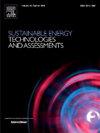多个互联国家光伏发电预测的深度学习框架
IF 7.1
2区 工程技术
Q1 ENERGY & FUELS
Sustainable Energy Technologies and Assessments
Pub Date : 2025-04-26
DOI:10.1016/j.seta.2025.104330
引用次数: 0
摘要
准确的光伏发电预测对于公用事业、电网运营商和市场参与者预测太阳能发电模式和调整运营策略至关重要。最近,深度学习(DL)已成为改善PV预测的一种有前途的方法。然而,训练深度学习模型通常需要大型数据集,这通常限制了光伏发电预测,限制了它们的全部潜力。纳入来自多个异质来源(如不同国家)的额外数据有助于解决这一限制,但同时也带来了与分布变化相关的挑战,这可能对预测准确性产生负面影响。光伏发电容量的快速扩张使预测变得更加复杂,因为发电模式会随着新装置的安装而改变。现有方法在有效利用来自多个来源的数据方面经常面临挑战。本文的主要新颖之处在于提出了一个基于dl的光伏预测框架,该框架整合了基础和国别培训。这种方法使该框架能够利用来自多个相互关联的国家的数据,从而改进泛化并提高预测准确性。此外,我们引入了一种适应机制,该机制可以动态地重新校准预测模型,以响应光伏容量的变化,而无需再培训,从而使我们的框架能够无缝地处理此类变化。根据三个相互关联的国家(希腊、保加利亚和罗马尼亚)的数据对拟议框架进行了评估,结果表明,通过利用跨国数据并适应不断变化的条件,该框架的准确性得到了显著提高。使用这三个相互关联的国家的数据尤为重要,因为每个国家的国内光伏生产可以直接影响邻国的出清价格和能源结构。这项工作突出了一个关键但尚未得到充分开发的研究方向,展示了通过有效利用大数据来实现更准确的基于DL的PV预测的潜力,这与DL在各个领域的最新进展是一致的。本文章由计算机程序翻译,如有差异,请以英文原文为准。
A deep learning framework for photovoltaic power forecasting in multiple interconnected countries
Accurate photovoltaic (PV) power forecasting is essential for enabling utilities, grid operators, and market participants to anticipate solar generation patterns and adjust operational strategies. Recently, Deep Learning (DL) has emerged as a promising approach for improving PV forecasts. However, training DL models typically require large datasets, which are often limited in PV power forecasting, restricting their full potential. Incorporating additional data from multiple heterogeneous sources, such as different countries, can help address this limitation but – at the same time − introduces challenges related to distribution shifts that can negatively impact forecasting accuracy. The rapid expansion of PV capacity further complicates forecasting, as generation patterns shift with new installations. Existing approaches often face challenges in effectively utilizing data from multiple sources. The main novelty of this paper lies in proposing a DL-based PV forecasting framework that integrates both foundational and country-specific training. This approach enables the framework to leverage data from multiple interconnected countries, improving generalization and enhancing forecasting accuracy. Additionally, we introduce an adaptation mechanism that dynamically recalibrates the forecasting model in response to changes in PV capacity, without the need for retraining, allowing our framework to seamlessly handle such variations. The proposed framework, evaluated on data from three interconnected countries (Greece, Bulgaria, and Romania), demonstrates significant improvements in accuracy by exploiting cross-country data and adapting to evolving conditions. Using data from these three interconnected countries is particularly important since each country’s domestic PV production can directly affect the clearing prices and the energy mix of the neighboring countries. This work highlights a critical yet underexplored research direction, demonstrating the potential for significantly more accurate DL-based PV forecasting by effectively utilizing big data, in line with recent advances in DL across various fields.
求助全文
通过发布文献求助,成功后即可免费获取论文全文。
去求助
来源期刊

Sustainable Energy Technologies and Assessments
Energy-Renewable Energy, Sustainability and the Environment
CiteScore
12.70
自引率
12.50%
发文量
1091
期刊介绍:
Encouraging a transition to a sustainable energy future is imperative for our world. Technologies that enable this shift in various sectors like transportation, heating, and power systems are of utmost importance. Sustainable Energy Technologies and Assessments welcomes papers focusing on a range of aspects and levels of technological advancements in energy generation and utilization. The aim is to reduce the negative environmental impact associated with energy production and consumption, spanning from laboratory experiments to real-world applications in the commercial sector.
 求助内容:
求助内容: 应助结果提醒方式:
应助结果提醒方式:


